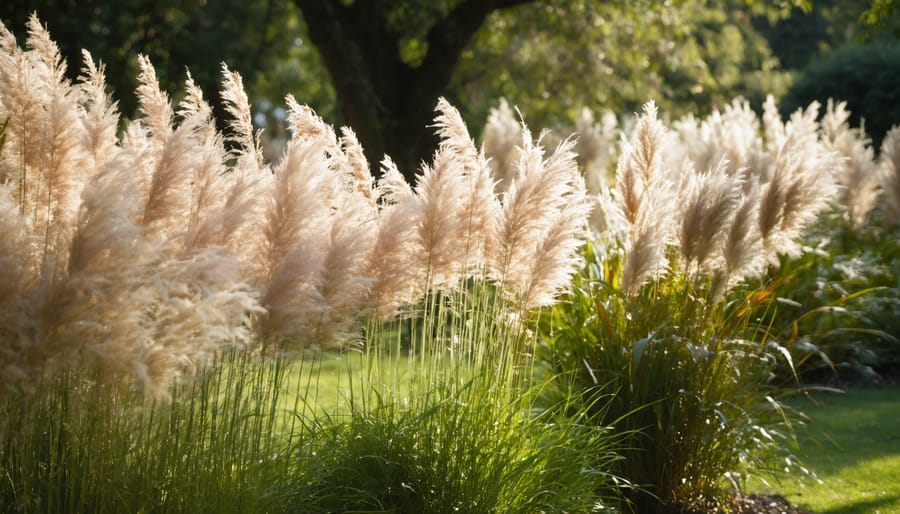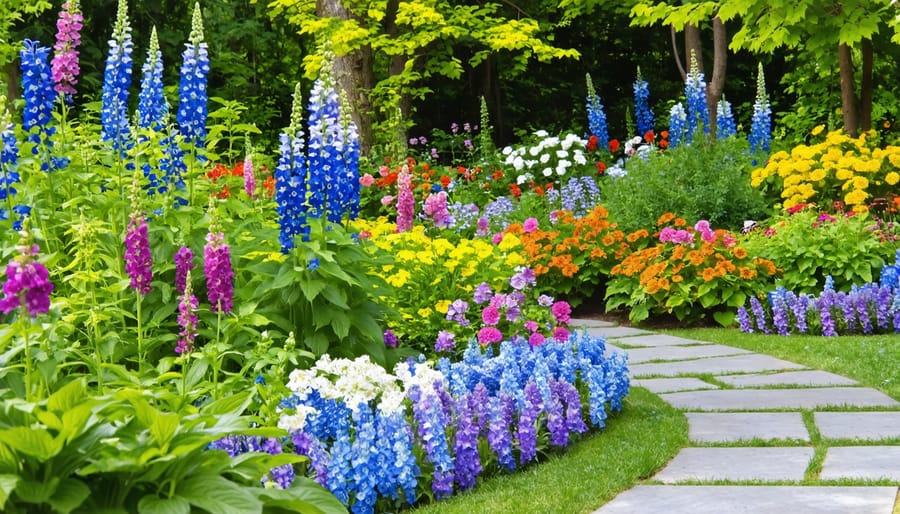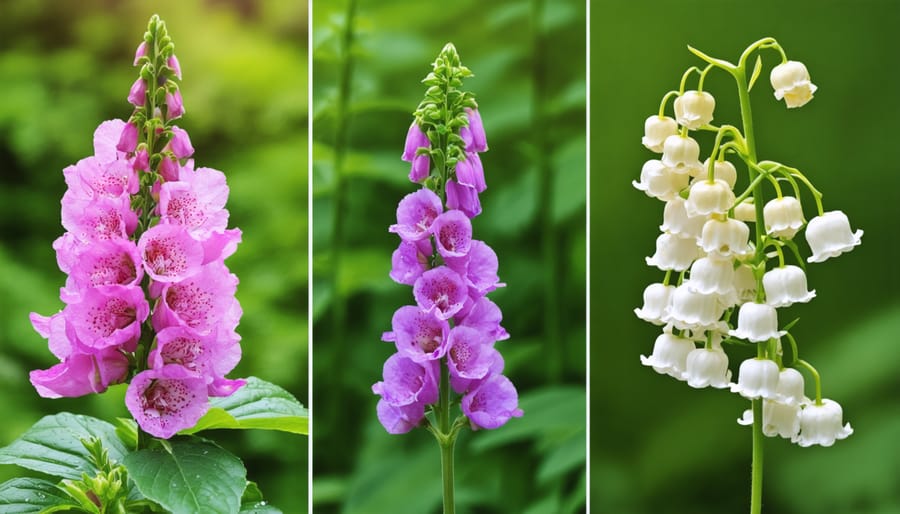Transform your vegetable garden into a sustainable food source by establishing perennial vegetables that return year after year, offering remarkable perennial garden benefits. Plant asparagus crowns 18 inches apart in trenches filled with rich, well-draining soil for decades of spring harvests. Establish artichoke beds in full sun locations with protective mulch during winter months, yielding tender hearts and flavorful leaves each season. Integrate perennial herbs like sage, thyme, and oregano along garden borders, creating permanent aromatic boundaries while attracting beneficial pollinators. Position rhubarb plants in corners where they won’t overshadow other crops, ensuring 3 feet of space between crowns for optimal growth. These long-term investments reduce annual planting work, build healthier soil structure, and provide reliable harvests with minimal maintenance. Strategic placement of these hardy vegetables creates a productive garden foundation that improves with age, while supporting local ecosystem health through permanent root systems and consistent ground cover.
Best Perennial Vegetables for Your Garden
Familiar Favorites
When it comes to reliable perennial vegetables, few are as beloved as asparagus. Once established, these tender spears will return year after year for up to 20 years, providing an early spring harvest that signals the start of the growing season. Plant them in a sunny, well-drained bed, and after the initial 2-3 year waiting period, you’ll be rewarded with abundant harvests.
Rhubarb is another classic perennial that adds both beauty and flavor to the garden. Its large, dramatic leaves create an impressive display, while its tart stalks are perfect for pies, jams, and desserts. Give rhubarb plenty of space and rich soil, and it will thrive for decades with minimal care beyond annual mulching and dividing every 5-7 years.
Artichokes bring a touch of Mediterranean flair to perennial gardens. While they’re typically grown as annuals in colder regions, these striking plants can survive winter in zones 7 and warmer. Their silvery-green foliage creates architectural interest, and the edible flower buds are a gourmet treat. Even if you don’t harvest them all, the purple thistle blooms are stunning.
These familiar favorites form the backbone of many perennial vegetable gardens, offering reliable harvests and becoming more productive with each passing year. They’re particularly valuable for gardeners looking to create a low-maintenance food landscape that provides fresh, homegrown produce with minimal annual replanting.
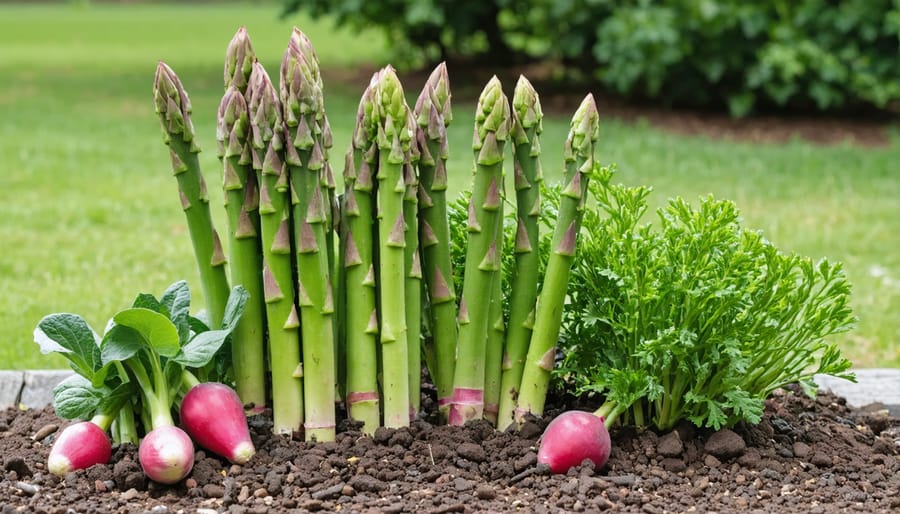
Lesser-Known Treasures
While most gardeners are familiar with common perennial vegetables like asparagus and rhubarb, there’s a whole world of fascinating lesser-known options that can add diversity to your garden. Take sunchokes, also known as Jerusalem artichokes, for example. These sunflower relatives produce nutty-flavored tubers that come back year after year, making them a delightful addition to fall soups and roasted vegetable medleys.
Sea kale is another hidden gem, producing tender, blanched shoots in spring that taste like a cross between asparagus and cabbage. Once established, this hardy perennial provides years of unique harvests and adds architectural interest to your garden with its blue-green leaves and white flower clusters.
Egyptian walking onions, or tree onions, are conversation starters in any garden. They earn their quirky name from the way they produce bulblets at the top of their stalks, which eventually become so heavy that they bend over and “plant” themselves, literally walking across your garden! These hardy plants provide both green onions and small bulbs throughout the season.
Consider adding Chinese artichokes (crosnes) to your collection. These crunchy, spiral-shaped tubers have a mild, nutty flavor and are particularly prized in Asian cuisine. They’re easy to grow and come back reliably each year, though you’ll want to contain them as they can spread enthusiastically.
Planning Your Perennial Vegetable Garden
Site Selection and Preparation
Selecting the perfect spot for your perennial vegetable garden is crucial for its long-term success. Choose a location that receives at least 6-8 hours of direct sunlight daily, as most edible perennials thrive in full sun. Consider the natural drainage of your chosen site – vegetables generally prefer well-draining soil and won’t tolerate waterlogged conditions.
Before planting, it’s essential to prepare soil for long-term success. Since perennial vegetables will occupy the same space for years, investing time in soil preparation pays dividends. Start by conducting a soil test to understand your soil’s pH and nutrient levels. Most vegetables prefer slightly acidic to neutral soil (pH 6.0-7.0).
Work in plenty of organic matter, such as compost, aged manure, or leaf mold, to a depth of at least 12-18 inches. This deep soil preparation encourages strong root development and ensures your perennial vegetables can access nutrients throughout their growing seasons. Consider raised beds if your native soil is particularly challenging or poorly draining.
Remember to leave adequate spacing between plants, as perennial vegetables often grow larger than their annual counterparts. Create paths between planting areas for easy access during maintenance and harvesting. If possible, choose a location close to a water source to make irrigation convenient, and consider installing a drip system for efficient watering.
Protection from strong winds is also beneficial, so consider natural windbreaks or plan to install fencing if needed. Your site should also allow for future expansion, as many gardeners find themselves wanting to add more perennial vegetables once they experience their first successful harvests.
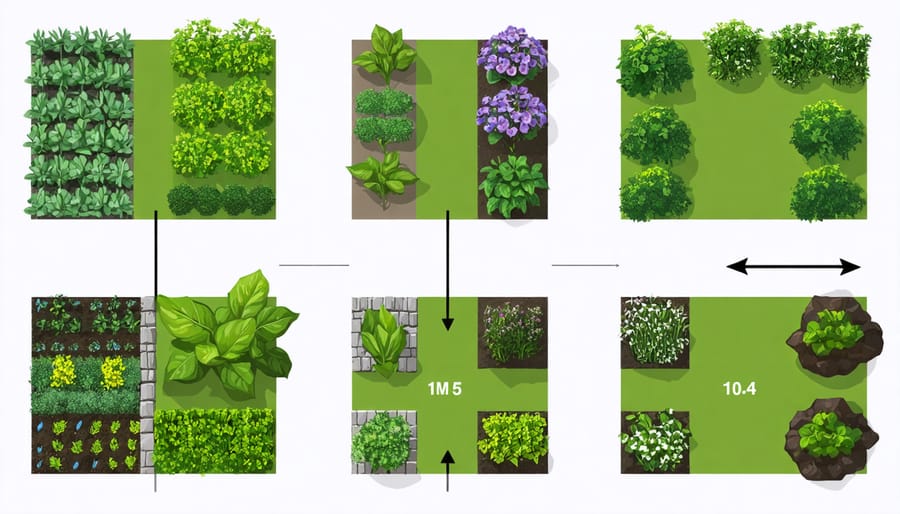
Companion Planting Strategies
Companion planting is a game-changer for your perennial vegetable garden, creating a thriving ecosystem where plants support each other’s growth and health. The key is to pair your perennial vegetables with complementary plants that enhance flavor, deter pests, or improve soil conditions.
Asparagus, for instance, grows beautifully alongside tomatoes and parsley. The tomatoes help repel asparagus beetles, while parsley’s shallow roots don’t compete with asparagus’s deeper root system. Plant some marigolds nearby to ward off harmful nematodes and add a splash of color to your garden.
Artichokes benefit from having aromatic herbs like thyme and oregano as neighbors. These herbs not only attract beneficial pollinators but also help mask the scent of your precious artichokes from potential pests. Consider planting clumps of chives around your perennial vegetables – their strong scent naturally deters aphids and other unwanted insects.
For rhubarb, try pairing it with alliums like garlic and onions, which help protect against various soil-borne diseases. Strawberries make excellent companions for many perennial vegetables, creating ground cover that helps retain soil moisture and suppress weeds.
When planning your companion planting strategy, remember to consider each plant’s mature size and growth habits. Tall perennials like Jerusalem artichokes work well with shade-tolerant plants beneath them, creating a vertical gardening system that maximizes space and productivity.
By thoughtfully combining different plants, you’ll create a more resilient garden that requires less intervention and provides better yields. Just remember to rotate your annual companions periodically to prevent soil depletion and disease buildup.
Maintenance and Care Tips
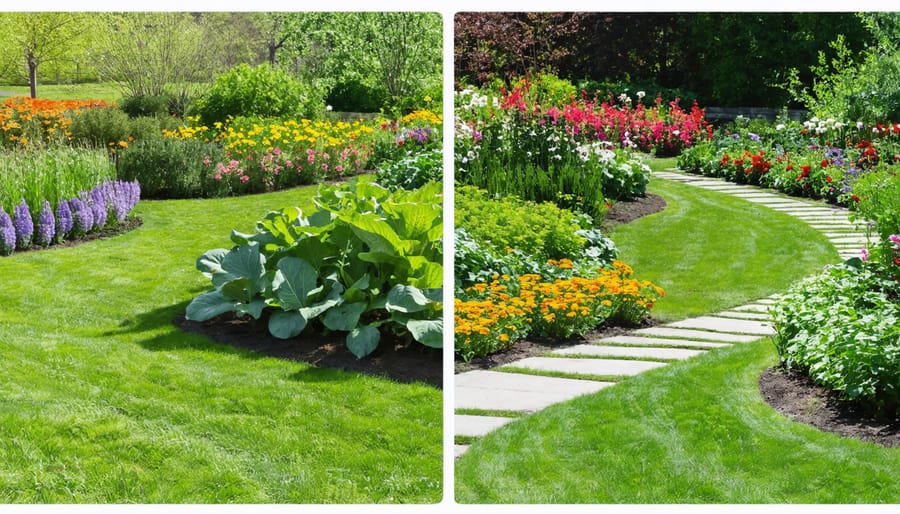
Seasonal Care Guide
A successful perennial vegetable garden requires regular attention throughout the year. Following our comprehensive seasonal maintenance guide will help ensure your plants thrive year after year.
In spring, focus on bed preparation and plant division. As the soil warms, remove winter mulch gradually and add fresh compost to rejuvenate the soil. This is the perfect time to divide overcrowded perennials like rhubarb and horseradish, giving them space to flourish. Watch for emerging shoots and protect them from late frosts with row covers.
Summer brings the peak growing season, requiring regular watering and mulching to retain moisture. Water deeply at soil level early in the morning to prevent fungal issues. Keep beds weed-free and monitor for pests, particularly on leafy perennials like sorrel and artichokes. Harvest regularly to encourage continuous production.
Fall is crucial for preparing your garden for winter. Cut back dead foliage, but leave some stems standing to protect crown roots. Apply a thick layer of organic mulch around plants, using materials like straw or leaves. This is also the ideal time to plant garlic and other fall-planted perennial vegetables.
Winter maintenance focuses on protection. In colder regions, add extra mulch around root zones and consider using cold frames for tender perennials. Check mulch levels after storms and adjust as needed. Use this quieter season to plan next year’s additions and review which varieties performed best in your garden.
Remember that specific plants may need additional care based on your climate zone. Observe your garden closely throughout the year, making notes about what works best in your particular growing conditions. This attention to seasonal needs will reward you with a thriving, productive perennial vegetable garden year after year.
Problem Prevention
Maintaining a healthy perennial vegetable garden requires vigilance and preventive measures to prevent common garden problems. Here are some tried-and-true strategies to keep your garden thriving year after year.
First, focus on soil health. Poor soil is often the root cause of many garden issues. Conduct annual soil tests and amend accordingly with organic matter. A healthy soil ecosystem naturally suppresses many plant diseases and supports stronger plants that can better resist pests.
Proper spacing is crucial for perennial vegetables. Overcrowding leads to poor air circulation, which can trigger fungal diseases. When planting, consider the mature size of each plant and give them room to grow. Remember, perennials will expand over the years!
Water management is another key factor. Consistent moisture is important, but avoid overhead watering, especially in the evening. This practice can lead to leaf diseases. Instead, use drip irrigation or soaker hoses to deliver water directly to the roots.
Keep an eye out for early signs of trouble. Regular garden walks help you spot potential issues before they become major problems. Look for discolored leaves, unusual growth patterns, or pest damage. Remove affected plant parts promptly to prevent spread.
Companion planting can naturally deter pests and enhance growth. For example, planting aromatic herbs like oregano or thyme near your perennial vegetables can confuse and repel unwanted insects. These helpful companions also attract beneficial insects that help control pest populations.
Mulching is your ally in problem prevention. A 2-3 inch layer of organic mulch helps suppress weeds, regulate soil temperature, and retain moisture. Just be sure to keep mulch away from plant stems to prevent rot.
Remember, a diverse garden is a resilient garden. Mixing different perennial vegetables creates natural barriers against pest and disease spread. Plus, it makes your garden more interesting and productive!
As we’ve explored throughout this article, perennial vegetables offer an incredible opportunity to create a sustainable, low-maintenance garden that provides fresh, nutritious produce year after year. By investing time in establishing these long-lasting plants, you’re not just creating a garden; you’re building a lasting food source that becomes more productive with each passing season.
Remember that success with perennial vegetables starts with careful planning and plant selection. Choose varieties that suit your climate, consider your available space, and think about the foods you and your family enjoy eating. Whether you start with familiar options like asparagus and rhubarb or venture into less common varieties like sea kale and sorrel, there’s a perennial vegetable to suit every garden and taste.
The beauty of perennial vegetable gardening lies in its sustainability. Once established, these plants require less water, fertilizer, and overall maintenance than annual vegetables. They also help improve soil health, support local wildlife, and reduce the carbon footprint associated with yearly tilling and replanting.
Don’t feel pressured to transform your entire garden overnight. Start small with one or two perennial vegetables, and gradually expand your collection as you gain confidence and experience. Learn from each season, observe what works best in your specific growing conditions, and adjust your approach accordingly.
The rewards of growing perennial vegetables extend far beyond the dinner table. There’s something deeply satisfying about watching these plants return year after year, knowing that your initial effort continues to pay dividends in fresh, homegrown produce. Plus, you’ll develop a deeper connection to your garden and the natural cycles that sustain it.
So why not take that first step today? Whether you have a sprawling backyard or just a few containers on a patio, there’s room in every garden for perennial vegetables. Your future self will thank you for starting this rewarding and sustainable gardening journey.


